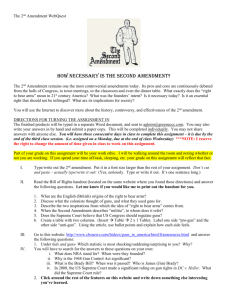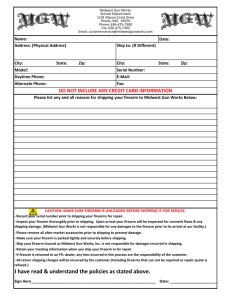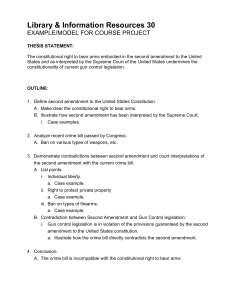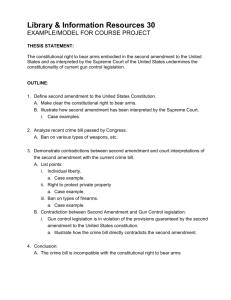Ideas for law review articles
advertisement
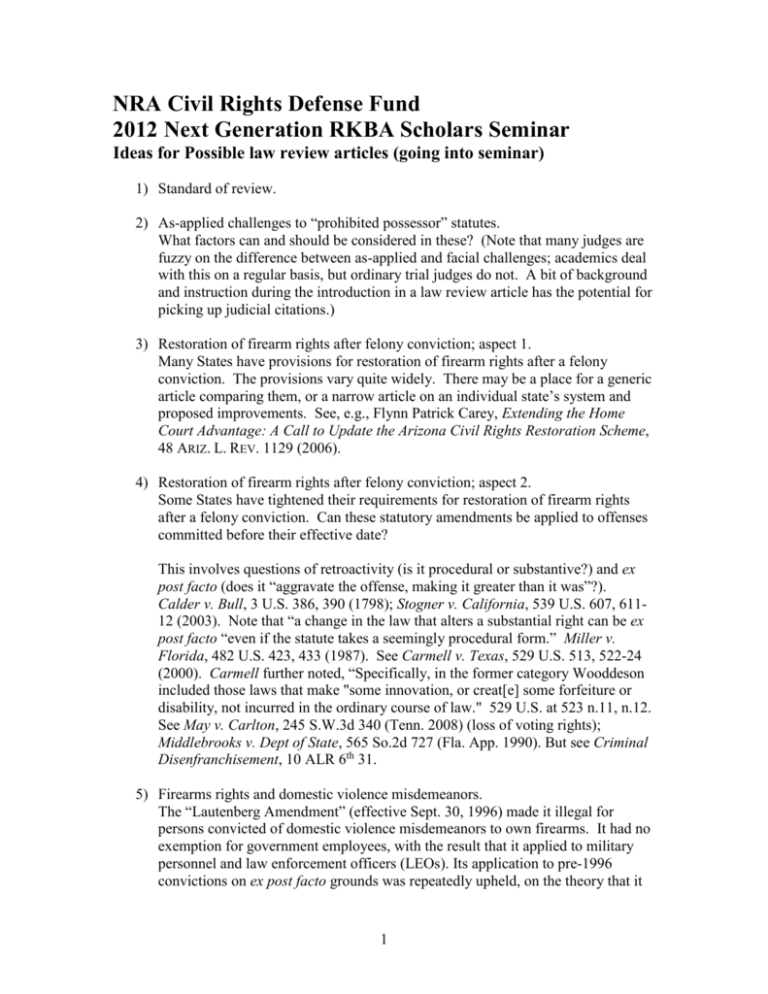
NRA Civil Rights Defense Fund 2012 Next Generation RKBA Scholars Seminar Ideas for Possible law review articles (going into seminar) 1) Standard of review. 2) As-applied challenges to “prohibited possessor” statutes. What factors can and should be considered in these? (Note that many judges are fuzzy on the difference between as-applied and facial challenges; academics deal with this on a regular basis, but ordinary trial judges do not. A bit of background and instruction during the introduction in a law review article has the potential for picking up judicial citations.) 3) Restoration of firearm rights after felony conviction; aspect 1. Many States have provisions for restoration of firearm rights after a felony conviction. The provisions vary quite widely. There may be a place for a generic article comparing them, or a narrow article on an individual state’s system and proposed improvements. See, e.g., Flynn Patrick Carey, Extending the Home Court Advantage: A Call to Update the Arizona Civil Rights Restoration Scheme, 48 ARIZ. L. REV. 1129 (2006). 4) Restoration of firearm rights after felony conviction; aspect 2. Some States have tightened their requirements for restoration of firearm rights after a felony conviction. Can these statutory amendments be applied to offenses committed before their effective date? This involves questions of retroactivity (is it procedural or substantive?) and ex post facto (does it “aggravate the offense, making it greater than it was”?). Calder v. Bull, 3 U.S. 386, 390 (1798); Stogner v. California, 539 U.S. 607, 61112 (2003). Note that “a change in the law that alters a substantial right can be ex post facto “even if the statute takes a seemingly procedural form.” Miller v. Florida, 482 U.S. 423, 433 (1987). See Carmell v. Texas, 529 U.S. 513, 522-24 (2000). Carmell further noted, “Specifically, in the former category Wooddeson included those laws that make "some innovation, or creat[e] some forfeiture or disability, not incurred in the ordinary course of law." 529 U.S. at 523 n.11, n.12. See May v. Carlton, 245 S.W.3d 340 (Tenn. 2008) (loss of voting rights); Middlebrooks v. Dept of State, 565 So.2d 727 (Fla. App. 1990). But see Criminal Disenfranchisement, 10 ALR 6th 31. 5) Firearms rights and domestic violence misdemeanors. The “Lautenberg Amendment” (effective Sept. 30, 1996) made it illegal for persons convicted of domestic violence misdemeanors to own firearms. It had no exemption for government employees, with the result that it applied to military personnel and law enforcement officers (LEOs). Its application to pre-1996 convictions on ex post facto grounds was repeatedly upheld, on the theory that it 1 was not increased “punishment” for the underlying offense, and its application depended upon future conduct (possessing the firearm). However, in the wake of Heller, might it be ex post facto on the ground that it aggravated the underlying offense by causing it to be one that forfeited a constitutional right? 6) Might the Federal prohibited-possessor statute be void for vagueness as applied to a person who received a firearm before he become a prohibited possessor, and continued to possess it after? (This is especially prominent where the prohibition is based upon a DV restraining order. Under Federal law, prohibited persons may not: (a) “ship or transport in interstate or foreign commerce”; (b) “possess in or affecting commerce” or (c) “receive any firearm or ammunition which has been shipped or transported in interstate or foreign commerce.” 18 USC §922(g). None of these fit a person who already had received a firearm or ammunition at the time he became a prohibited person. But Scarborough v. United States, 431 U.S. 563 (1977), held on exactly these facts that continuing to possess was a violation. (Scarborough construes the pre-1986 version of the Gun Control Act, which was an incredible mess. The bar on receipt and possession was codified separately from the bar on dealers selling to those so barred, and the two sets of provisions were inconsistently drafted.) The Gun Control Act of 1968, as amended, had its bar on prohibited possessors in a separate section, 18 U.S.C. 1202 (Appendix). The version codified in the appendix had its preamble also codified, which stated that possession by prohibited persons affected commerce. The Court read the bar together with this preamble, and concluded that the two together meant that any prohibited person who possessed did so “in or affecting commerce.” Query whether this remains viable in the wake of Lopez. Might a novel form of void for vagueness be arguable here? In 1986, the Firearm Owners Protection Act repealed 18 U.S.C. 1202 (Appendix) and simply folded the ban on possession into the bans on receiving contained in the main Gun Control Act (18 U.S.C. §921 et seq.). The preamble to 18 U.S.C. 1202 Appendix vanished – indeed, was repealed. Today, a reasonable person reading the face of the statute would not realize that continued possession was forbidden; that would require research in the U.S. Reports, and knowing to look up the earlier statute in the Statutes at Large. 7) Requirements of government-issued picture ID. One of the present Executive’s legal priorities appears to be to overturn State laws requiring government-issued picture ID in order to register to vote. But government issued picture ID is required to purchase any firearm from a licensed dealer, and if the dealer fails to get and record it, he commits a felony. The right to possess a firearm for self defense is at least as fundamental as the right to vote - which is denied to those under age 18, and at the time of the 14th Amendment, 2 was denied to women as well, and at the time of the 2nd Amendment, was denied (depending upon the State) to those who did not own property, or did not pay taxes. 8) Possibility of Congressional implementation of the civil right under Section 5 of the 14th Amendment. 9) Concealed carry and the 2nd Amendment. Some 19th Century authorities thought the right to arms protected only open carry. Don Kates says that he knows of no 18th Century authority on this. 10) Gun registration and the 2nd Amendment. Don Kates’ 1983 Michigan Law Review article (Handgun Prohibition and the Original Meaning of the Second Amendment, 82 Mich. L. Rev. 204-273) says registration is consistent with the 2nd Amendment because colonial laws required all to own guns and provided for inspections to confirm that they were owned. How persuasive is this in modern life where 50% of populace does not own guns and gun owner anonymity is a protection against tyrannous disarmament? 11) 2nd Amendment rights for criminals and illegal aliens? Obviously people who have been convicted of violent felonies should not be allowed gun. (Forever? For 20 years after conviction? For some other time span?) What about people convicted of non-violent felonies? What about people convicted of trivial felonies? What about people convicted of misdemeanors – violent or non-violent? What about illegal aliens? See discussion in Kates & Cramer, Second Amendment Limitations and Criminological Considerations, 60 HASTINGS LAW JOURNAL 1339 (2009). See also C. Kevin Marshall, Why Can’t Martha Stewart Have a Gun?, 32 HARV. J. OF LAW & PUB. POLICY (2009). 12) Deterrence from an armed citizenry. Gun owners believe that civilian gun ownership and defensive use deter crime. Studies (as opposed to diatribes) say this is partially correct but disagree as to how important the deterrent effect is. Compare Lott, MORE GUNS, LESS CRIME (3d ed. 2010) to other appraisals, especially Kleck in Kleck & Kates, ARMED: NEW PERSPECTIVES ON GUN CONTROL (2001). 13) Viability of the retreat rule in modern America? A shrinking minority of American states require retreat before the use of deadly force. But this is only if retreat is possible with complete safety. See discussion in People v. Riddle 47 Mich. 116, 649 N.W.2d 30, 2002; however, note that Michigan has now enacted the Marian Hammer statute abolishing the retreat rule. 3 14) Evaluating the Marian Hammer statute. Marian Hammer is a former National Rifle Association president and tireless lobbyist. A statute she has drafted does many things about the retreat rule including abolishing it. This statute has been adopted in almost 30 states (many of which never had the retreat rule). See also statutes in CA, WA, and CO. 4
